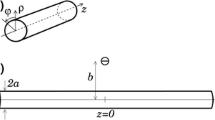Summary
It has been shown in an earlier paper that the slow transient decrease in conductance, somtimes referred to as “creep”, obtained with small-to-medium hyperpolarizing current or voltage pulses is due to K+ transport number differences across the walls of the transverse tubular system. Using the same basic numerical analysis and the parameters already obtained experimentally in the previous paper for frog skeletal muscle in a sulphate Ringer's solution, this paper predicts the equivalent membrane capacitance and dynamic resistance due to transport number effects for very low amplitude and low frequency sinusoidal currents from the phase lag of the voltage response behind the current. Such sinusoidal currentper se give rise to an equivalent capacitance which increased from less than 1μF·cm−2 at 10 Hz to about 16μF·cm−2 at 0.01 Hz and to an equivalent dynamic membrane resistance which increases from its instantaneous slope resistance value of 11.7kωcm2 at 10 Hz to about 16kωcm2 at 0.01 Hz. Similar small sinusoidal components of current superimposed on depolarizing and hyperpolarizing pulses (25–45 mV) give rise to even greater “capacitances” at low frequencies (e.g., 24–28μF·cm−2 at 0.01 Hz). The response due to large sinusoidal currents was also investigated. These transport number effects help to explain the small discrepancies obtained by some workers between experimental and predicted values of skeletal muscle fiber impedances measured in the 1–10 Hz range and would seem to be critical for the interpretation of any skeletal muscle fiber impedance studies done at frequencies less than 1 Hz.
Similar content being viewed by others
References
Adrian, R. H., Chandler, W. K., Hodgkin, A. L. 1969. The kinetics of mechanical activation in frog muscle.J. Physiol. (London) 204:207
Adrian, R. H., Chandler, W. K., Hodgkin, A. L. 1970a. Voltage clamp experiments in striated muscle fibres.J. Physiol. (London) 208:607
Adrian, R. H., Chandler, W. K., Hodgkin, A. L. 1970b. Slow changes in potassium permeability in skeletal muscle.J. Physiol. (London) 208:645
Adrian, R. H., Freygang, W. H. 1962. The potassium and chloride conductance of frog muscle membrane.J. Physiol. (London) 163:61
Almers, W. 1972a. Potassium conductance changes in skeletal muscle and the potassium concentration in the transverse tubules.J. Physiol. (London) 225:33
Almers, W. 1972b. The decline of potassium permeability during extreme hyperpolarisation in frog skeletal muscle.J. Physiol. (London) 225:57
Barry, P. H. 1976. Transport number effects in the transverse tubular system of muscle and their effects on low frequency A/C impedance analysis.Proc. Aust. Physiol. Pharmacol. Soc. 7:4P
Barry, P. H., Adrian, R. H. 1973. Slow conductance changes due to potassium depletion in the transverse tubules of frog muscle fibers during hyperpolarizing pulses.J. Membrane Biol. 14:243
Barry, P. H., Hope, A. B. 1969a. Electroosmosis in membranes: Effects of unstirred layers and transport numbers. I. Theory.Biophys. J. 9:700
Barry, P. H., Hope, A. B. 1969b. Electroosmosis in membranes: Effects of unstirred layers and transport numbers. II. Experimental.Biophys. J. 9:729
Coster, H. G. L., Smith, J. R. 1974a. The effect of pH on the low frequency capacitance of the membranes ofChara corallina.In: Membrane Transport in Plants. Pp. 154–161. U. Zimmermann and J. Dainty, editors. Springer-Verlag, Heidelberg
Coster, H. G. L., Smith, J. R. 1974b. The molecular organisation of bimolecular lipid membranes. A study of the low frequency Maxwell-Wagner impedance dispersion.Biochim. Biophys. Acta 373:151
Dewhurst, D. J. 1960. Concentration polarisation in plane membrane-solution systems.Trans. Faraday Soc. 56:599
Eisenberg, R. S., Gage, P. W. 1969. Ionic conductances of the surface and transverse tubular membranes of frog sartorius fibers.J. Gen. Physiol. 53:279
Endo, M. 1966. The entry of fluorescent dyes into the sarcotubular system of the frog muscle.J. Physiol. (London) 185:224
Huxley, H. F. 1964. Evidence for continuity between the central elements of the triads and the extracellular space in frog sartorius muscle.Nature (London) 202:1067
Katz, B. 1949. Les constantes électriques de la membrane du muscle.Arch. Sci. Physiol. 3:285
McCracken, D. D. 1965. A Guide to Fortran IV Programming. John Wiley and Sons, New York
Mobley, B. A., Eisenberg, B. R. 1975. Sizes of components in frog skeletal muscle measured by methods of sterology.J. Gen. Physiol. 66:31
Page, S. G. 1964. The organisation of the sarcoplasmic reticulum in frog muscle.J. Physiol. (London) 175:10P
Peachey, L. D. 1965. The sarcoplasmic reticulum and the transverse tubules of the frog's sartorius.J. Cell. Biol. 25:209
Ralston, A. 1965. A First Course in Numerical Analysis. McGraw-Hill, New York
Schaefer, H., Scholmerich, P., Haass, P. 1939. Der Elektrotonus und die Erregungsgesetze des Muskels.Pfluegers Arch. Gesamte Physiol. 241:310
Segal, J.R. 1967. Electrical capacitance of ion-exchanger membranes.J. Theor. Biol. 14:11
Sokolnikoff, I. S., Redheffer, R. M. 1958. Mathematics of Physics and Modern Engineering. McGraw-Hill, New York
Tasaki, I., Hagiwara, S. 1957. Capacity of muscle fiber membrane.Am. J. Physiol. 188:423
Valdiosera, R., Clausen, C., Eisenberg, R. S. 1974a. Circuit models of the passive electrical properties of frog skeletal muscle fibers.J. Gen. Physiol. 63:432
Valdiosera, R., Clausen, C., Eisenberg, R.S. 1974b. Impedance of frog skeletal muscle fibers in various solutions.J. Gen. Physiol. 63:460
Wedner, H. J., Diamond, J. M. 1969. Contributions of unstirred-layer effects to apparent electrokinetic phenomena in the gall bladder.J. Membrane Biol. 1:92
Author information
Authors and Affiliations
Rights and permissions
About this article
Cite this article
Barry, P.H. Transport number effects in the transverse tubular system and their implications for low frequency impedance measurement of capacitance of skeletal muscle fibers. J. Membrain Biol. 34, 383–408 (1977). https://doi.org/10.1007/BF01870310
Received:
Issue Date:
DOI: https://doi.org/10.1007/BF01870310




